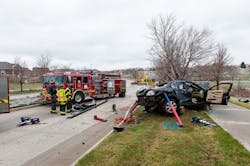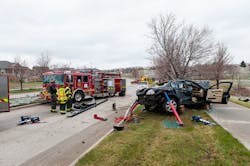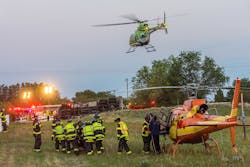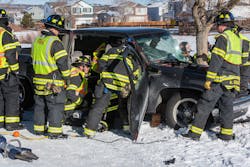Patient Outcomes Depend on the Company Attitude
After all, we are talking about fire-based EMS—where EMS is a profession buried in the fire service. By nature of this association, EMS becomes a second-rate citizen rarely living up to the excitement of a fire call or not able to compete with the adrenaline of a building fire. You know the verbal or visual sighs that occur when the tones sound for a medical versus the outward excitement when those same tones sound for a fire of any kind.
It’s time to change the conversation. I’m not going to spend time trying to convince you of the importance of EMS, of the number of lives saved in the pre-hospital world, or of the reality that most of our calls are medical in nature. We are going to discuss how your actions in the firehouse, your attitude towards the crew, and the process at which you approach “those calls” matter to the patient outcome.
For the past few years, our department has been sending several members to paramedic school—taken offline, expenses paid, opportunity waiting. The problem is that in almost every one of those cycles, we have had a hard time filling the available spots. So, we started to ask ourselves why this was happening, and the answer—while not fully realized—has proven to be more complex than we originally thought.
The reality is that there might be several organizational issues that exist. There are cultural issues that exist. There are pay issues that exist. There are staffing issues that exist. The problem is that at a company level, most of us have no ability to change or affect any of those. But it’s at the company level that most of these issues stem, and it’s at the company level that the conversation gets changed.
As already noted, the us (fire) versus them (EMS) is a toxic atmosphere, and even unintentional toxicity breeds poor performance. In various studies, this type of negativity is realized by more accidents, more errors and more defects. In studies by the Queens School of Business and by the Gallup Organization, disengaged workers had 37 percent higher absenteeism, 49 percent more accidents, and 60 percent more errors and defects. And we can agree that patients will be the unfortunate beneficiaries of a more error- and accident-prone crew. There are three key elements to establishing a better environment, which in turn leads to better patient outcome.
Stop being a leader
Perhaps the most counterintuitive thing for official (or unofficial) leaders to do is to stop being the leader, yet it is perhaps one of the most effective ways to build a collaborative team. On the scene of EMS calls, the EMT or paramedic needs to be the one leading the scene—not always the company officer.
If I were in a conversation with the lead executive of SpaceX and had a question about how the launch mechanism works on the Falcon 9 rocket, she wouldn’t provide me the explanation, she would point me to the engineer who leads the launch team. An EMS scene is no different, where the officer does not need to be the one running the scene or making patient decisions, that needs to be left in the hands of the expert on your crew.In many agencies, the officer or senior member might be the one holding the highest medical certificate, which actually provides the opportunity to be the one in the weeds, and let someone else keep the high-level view. As we embrace outcome over rank, we realize that the best people for the job might not be the ones with the promotion, but are the ones with the appropriate knowledge base and the needed experience. On the scene of a medical call, this translates to the patient receiving the best care from the best people on the scene.
Building the collaborative EMS crew goes beyond the need to understand roles on the incident scene, it works all angles of crew life—perhaps most importantly at the firehouse. Many conversations have been had between a senior and junior member of the crew that goes something like “you don’t want to go to paramedic school, you’ll have too much paperwork, too many calls, and have too much legal responsibility.”
Leadership expert Simon Sinek calls it understanding the “why” and it is our responsibility as officers or senior members of a crew to explain the “why” and manage the negative conversations around anything, let alone something as critical to our profession as medicine. So much of how we think about something (not just for the young members) is formulated and vetted in the firehouse, so when experienced members impart negative wisdom on the aspirations of others, it can become a difficult obstacle to overcome.
Be more engaging
Few things are more transparent than the disinterest of crew members. When you are on the scene of a difficult breather call, and most of the crew is standing in the hallway chatting about anything but the current call, it is not only obvious to the members engaged with the patient, but also to the patient themselves.
If we study the workings of a race car pit crew, we see a lot of similarities to how we approach fire-based EMS. The biggest of which is a shared and common purpose—they are aligned in their intent and in their actions. Each person understands their role, and the race car wouldn’t ever finish the race without each person being fully engaged in the positive outcome of each pit stop.As you are working to change the overall vibe of your crew towards a better-working EMS team, there is no better way to do that than by discontinuing the role of the casual observer. Oftentimes, this role is filled by the senior members of the crew and is a product of a lack of passion, a lack of knowledge, or some deep-seeded complacency.
One of the best ways to work through each of those issues is via training. Company-level EMS training is critical to the success of the crew, and vital to the outcome of the patient. Just like our ability to put into place a fast interior attack on a fire is critical to that incident, so is our ability to rapidly assess, treat, and transport a serious patient. This does not come by coincidence or serendipity; this comes by excellence in training.
At the company level, we are often overwhelmed with the need to get in our required, certification-driven training hours—leaving us with a less-than-desired ability to get company level drills accomplished. On the time-management spectrum, one benefit to company-based EMS drills is that they are relatively easy to set up with little or no travel time. Grab the bags off the truck, find a crew member to be the patient, and off you go. As with anything on the drill ground, these trainings provide the crew with opportunities to try new roles, expand their knowledge, have a safe place to admit their shortcomings, and build proficiencies that can immediately translate to the incident scenes.
Embrace the upside
Listen, we can talk all day about how a well-performing, well-trained, engaged crew will lead to better patient outcomes; but there are still the realities of EMS response. Of course, reframing your attitude and building a passionate crew will help, but there are times when your actions need to go beyond that.
Two complaints that we hear the most from the ambulance crews center on the officers or the department being unable or unwilling to be empathetic to the workload of those doing the transports. It might manifest as a requirement by the officer that everyone be present for all events of the day, regardless of the potential backlog of reports or vehicle and supply maintenance that this requirement might create. It might also manifest as the ambulance crew being frequently pulled from training to run another call, thus missing out on numerous trainings and the opportunities that those provide.While our industry is emergency call initiated and outcome focused, at the company level we need to manage our time and energy in a way that allows for the best outcomes to exist. Exhausted crews do not provide great care. Crews concerned about hours’ worth of pending reports don’t provide great care. Untrained crews don’t provide great care.
It is important that you advocate for your crew by ensuring that they are able to attend training, by reworking the daily schedule to allow them the needed time to reset after a call, and by giving them the recovery time to ensure their readiness for the entire shift. Sometimes this means that you need to change your plans or rotate your crews; but it is important to understand that this is not because of the medical call, it is because we had the opportunity to help a citizen.
The final piece to making this work is changing how we understand the call types. Each time the station tones sound, we need to think of it as an opportunity to help a member of our community—and it doesn’t matter if that is by putting out a fire, helping them back into bed, changing the batteries in their smoke detectors, extricating them from a vehicle accident, or transporting them to the hospital. They are all just versions of the same thing, and it’s what we signed up to do.
This starts with you. It doesn’t matter if you are new to the job or near retirement, you can build a better version of your crew that will immediately have positive impact on patient outcome.
Reference
Seppälä, E. and Cameron, K. “Proof That Positive Work Cultures Are More Productive.” Harvard Business Review. Dec. 1, 2015. https://hbr.org/2015/12/proof-that-positive-work-cultures-are-more-productive.




